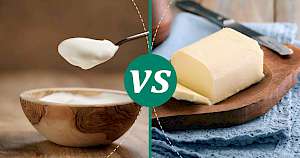Butter vs Sour Cream 18% Fat: Nutrition & Calories Compare


Butter vs Sour cream 18%
Nutrition Facts
Serving size:
change
5g10g15g20g30g40g50g60g80g100g120g140g160g180g200g220g250g300g350g400g450g500g600g700g800g900g1000g
1oz2oz3oz4oz5oz6oz7oz8oz10oz12oz15oz20oz25oz30oz35oz40oz50oz
Amount Per Serving:
Serving size:
change
5g10g15g20g30g40g50g60g80g100g120g140g160g180g200g220g250g300g350g400g450g500g600g700g800g900g1000g
1oz2oz3oz4oz5oz6oz7oz8oz10oz12oz15oz20oz25oz30oz35oz40oz50oz
Amount Per Serving:
Butter vs Sour Cream 18% 100g Compare
| per 100g | Butter | Sour cream 18% fat |
|---|---|---|
| Calories | 717 | 181 |
| Carbohydrates | 0.06 g | 7 g |
| Fat | 81.11 g | 14.1 g |
| Protein | 0.85 g | 7 g |
| Water | 16.17 g | 71 g |
| Calcium | 24 mg | 141 mg |
| Iron | 0.02 mg | 0.06 mg |
| Magnessium | 2 mg | 11 mg |
| Phosphorus | 7 mg | 0.7 mg |
| Potassium | 24 mg | 211 mg |
| Sodium | 11 mg | 70 mg |
| Zink | 7 mg | 0.7 mg |
| Vitaminium A | 2499 µg | 436 µg |
| Vitaminium B1 (Thiamine) | 0.005 mg | 0.04 mg |
| Vitaminium B2 (riboflavin) | 0.034 mg | 0.24 mg |
| Vitaminium B3 (Niacin) | 0.042 mg | 0.07 mg |
| Vitaminium B6 | 0.003 mg | 0.02 mg |
| Vitaminium B9 (Folic acid) | 0.003 mg | 0.011 mg |
| Vitaminium E | 2.32 mg | 0.4 mg |
| Vitaminium K | 0.007 µg | 0.001 µg |
Delving into the Creamy World of Butter and Sour Cream
Butter and sour cream are staples in many kitchens around the globe, beloved for their rich flavors and versatile applications in cooking and baking. Before we dive into the creamy details of butter and sour cream with 18% fat, let's sprinkle in some fascinating facts that might surprise you. Did you know that butter has been used as a cooking ingredient for thousands of years, with evidence of its use dating back to 2000 BC? On the other hand, sour cream, with its tangy twist, is a relatively newer addition to the culinary world, having gained popularity in the last few centuries. Both of these dairy delights have more to offer than just taste; they come with their own set of nutritional benefits and culinary uses that can enhance any dish.
The Nutritional Cream of the Crop
When comparing butter and sour cream (18% fat), it's clear that both bring their own unique nutritional profiles to the table. Butter is significantly higher in calories, with 717 calories per 100 grams, compared to sour cream's more modest 181 calories. This is largely due to butter's higher fat content, which sits at a hefty 81.11 grams, while sour cream contains 14.1 grams. However, it's not just about the fat; sour cream offers more in terms of certain nutrients. For instance, it has a higher protein content (7 grams) compared to butter (0.85 grams), and it's also richer in calcium, magnesium, potassium, and vitamins such as vitamin A, B2, and C.
Despite these differences, both butter and sour cream contain minimal carbohydrates and sugars, making them suitable for low-carb diets. However, the high cholesterol content in butter (215 mg) compared to sour cream (35 mg) might make the latter a more heart-friendly option for some people.
Culinary Uses and Flexibility
Butter and sour cream are not just about nutrition; their culinary uses are vast and varied. Butter, with its high fat content, is ideal for baking, offering a rich flavor and tender texture to cakes, cookies, and pastries. It's also a staple in sauces and as a base for sautéing vegetables or meats. Sour cream, with its tangy profile, is perfect for adding depth to soups and stews, dolloping on baked potatoes, or mixing into dips and dressings. Its lower fat content compared to butter makes it a lighter, yet still creamy, addition to recipes.
Furthermore, the unique properties of each can inspire creativity in the kitchen. For example, sour cream can be used to tenderize baked goods, while butter, when browned, can add a nutty, complex flavor to simple dishes.
Choosing Between Butter and Sour Cream
Deciding whether to use butter or sour cream depends on both your nutritional needs and culinary goals. If you're looking for a rich flavor enhancer for your baking and cooking, butter is your go-to. However, if you're aiming for a lighter, tangier touch with added nutritional benefits like higher protein and lower cholesterol, sour cream might be the better choice. In the end, both ingredients have their place in a well-rounded kitchen, offering delicious ways to enrich your meals.
Whether you're spreading butter on a warm piece of toast or dolloping sour cream on a spicy bowl of chili, these dairy products bring joy and flavor to our plates. Understanding their nutritional profiles and best uses can help you make informed choices that cater to your taste and health. So next time you're in the kitchen, consider reaching for that tub of sour cream or stick of butter with a newfound appreciation for their creamy goodness.
Butter 100g
717kcalCalories source
- 0% CARBS.
- 0% PROTEIN
- 100% FAT
Sour cream 18% fat 100g
181kcalCalories source
- 15% CARBS
- 15% PROTEIN
- 69% FAT
Compares of butter
- Butter vs Blue Cheese
- Butter vs Brie
- Butter vs Camembert
- Butter vs Cottage Cheese
- Butter vs Feta Cheese
- Butter vs Gouda Cheese
- see all compares of butter
Compares of sour cream 18%
Read also:
- Calories from Butter
- Calories of Blood sausage
- Calories in Pork
- Squid calories per 100g
- Agave syrup protein per 100g
- How many calories do zebra cakes have?
- Calories in a half of cutie clementine
- Calories in whole cutie clementine
- Calories for one, two or more cutie clementines
- How much protein in ricotta cheese?
Marcin Piotrowicz
calories-info.com creator
Healthy diet and healthy lifestyle promoter
Add comment